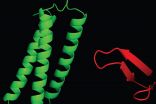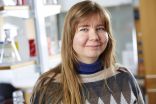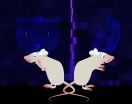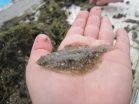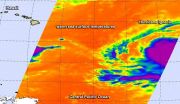(Press-News.org) Isaac Newton was a classic neurotic. He was a brooder and a worrier, prone to dwelling on the scientific problems before him as well as his childhood sins. But Newton also had creative breakthroughs--thoughts on physics so profound that they are still part of a standard science education.
In a Trends in Cognitive Sciences Opinion paper published August 27, psychologists present a new theory for why neurotic unhappiness and creativity go hand-in-hand. The authors argue that the part of the brain responsible for self-generated thought is highly active in neuroticism, which yields both of the trait's positives (e.g., creativity) and negatives (e.g., misery).
People who score high on neuroticism in personality tests tend to have negative thoughts and feelings of all types, struggle to cope with dangerous jobs, and are more likely to experience psychiatric disorders within their lifetime. The most popular explanation for why people are neurotic comes from British psychologist Jeffrey Gray, who proposed in the 1970s that such individuals have a heightened sensitivity to threat. He reached this conclusion after observing how antianxiety drugs reduced the sensitivity of rodents to cues of punishment and also helped to relax and liven up psychiatric patients.
"Gray had a useful and logical theory, but the problem is that it doesn't account for the full spectrum of neuroticism--it's pretty difficult to explain neuroticism in terms of magnified threat perception because high scorers often feel unhappy in situations where there is no threat at all," says paper lead author Adam Perkins, a personality researcher at King's College London. "The second problem is, there's literature showing neuroticism scores are positively correlated with creativity; and so why should having a magnified view of threat objects make you good at coming up with new ideas?"
Perkins' eureka moment came after attending a lecture by coauthor and University of York psychologist Jonathan Smallwood, a leading expert on the neural basis of daydreaming. Smallwood described his research during the lecture, including a key study which showed that individuals at rest in an MRI scanner who spontaneously have particularly negative thoughts (a key marker of neuroticism) displayed greater activity in the regions of the medial prefrontal cortex that are associated with conscious perception of threat. Perkins realized that individual differences in the activity of these brain circuits that govern self-generated thought could be a causal explanation for neuroticism.
They collaborated with Dean Mobbs of the Columbia University Fear, Anxiety, and Biosocial Lab, who is an expert on the neural basis of defense in humans. Mobbs had previously shown that there is a switch from anxiety-related forebrain activity to panic-related midbrain activity as a threat stimulus moves closer. Mobbs had also showed that this switch from anxiety to panic is controlled by circuits in the basolateral nuclei of the amygdala--the brain's emotional center.
"It occurred to me that if you happen to have a preponderance of negatively hued self-generated thoughts due to high levels of spontaneous activity in the parts of the medial prefrontal cortex that govern conscious perception of threat and you also have a tendency to switch to panic sooner than average people, due to possessing especially high reactivity in the basolateral nuclei of the amygdale, then that means you can experience intense negative emotions even when there's no threat present," Perkins says. "This could mean that for specific neural reasons, high scorers on neuroticism have a highly active imagination, which acts as a built-in threat generator."
The psychiatric relevance of this theory was highlighted by psychiatrist and coauthor Danilo Arnone, who argued that this novel cognitive model might help to explain the ruminative thinking pattern seen in depression and is complementary to the already defined role of the subgenual prefrontal cortex in the aetiology of mood dysregulation.
The overthinking hypothesis also explains the positives of neuroticism. The creativity of Isaac Newton and other neurotics may simply be the result of their tendency to dwell on problems far longer than average people. "I keep the subject constantly before me, and wait till the first dawnings open slowly, by little and little, into a full and clear light," Newton once said of his problem-solving method.
"We're still a long way off from fully explaining neuroticism, and we're not offering all of the answers, but we hope that our new theory will help people make sense of their own experiences, and show that although being highly neurotic is by definition unpleasant, it also has creative benefits," Perkins says. "Hopefully our theory will also stimulate new research as it provides us with a straightforward unifying framework to tie together the creative aspects of neuroticism with its emotional aspects."
INFORMATION:
The authors are funded by the National Institute for Health Research Mental Health Biomedical Research Centre, the NHS Foundation Trust, the Institute of Psychiatry, King's College London, and the Academy of Medical Sciences.
Trends in Cognitive Sciences, Perkins et al.: "Thinking too much: self-generated thought as the engine of neuroticism" http://dx.doi.org/10.1016/j.tics.2015.07.003
Trends in Cognitive Sciences (TICS), published by Cell Press, is a monthly review journal that brings together research in psychology, artificial intelligence, linguistics, philosophy, computer science, and neuroscience. It provides a platform for the interaction of these disciplines and the evolution of cognitive science as an independent field of study. For more information, please visit http://www.cell.com/trends/cognitive-sciences. To receive media alerts for TICS or other Cell Press journals, please contact press@cell.com.
Researchers at the Virginia Bioinformatics Institute at Virginia Tech have uncovered key cellular functions that help regulate inflammation -- a discovery that could have important implications for the treatment of allergies, heart disease, and certain forms of cancer.
The discovery, to be published in the Oct. 6 issue of the journal Structure, explains how two particular proteins, Tollip and Tom1, work together to contribute to the turnover of cell-surface receptor proteins that trigger inflammation.
"The inflammatory response can be a double-edged sword," said Daniel ...
Mobility between different physical environments in the cell nucleus regulates the daily oscillations in the activity of genes that are controlled by the internal biological clock, according to a study that is published in the journal Molecular Cell. Eventually, these findings may lead to novel therapeutic strategies for the treatment of diseases linked with disrupted circadian rhythm.
So called clock-controlled - or circadian - genes are part of the internal biological clock, allowing humans and other light-sensitive organisms to adjust their daily activity to the cycle ...
Cold Spring Harbor, NY - When a large combat unit, widely dispersed in dense jungle, goes to battle, no single soldier knows precisely how his actions are affecting the unit's success or failure. But in modern armies, every soldier is connected via an audio link that can instantly receive broadcasts - reporting both positive and negative surprises - based on new intelligence. The real-time broadcasts enable dispersed troops to learn from these reports and can be critical since no solider has an overview of the entire unit's situation.
Similarly, as neuroscientists at Cold ...
LA JOLLA--Every organism--from a seedling to a president--must protect its DNA at all costs, but precisely how a cell distinguishes between damage to its own DNA and the foreign DNA of an invading virus has remained a mystery.
Now, scientists at the Salk Institute have discovered critical details of how a cell's response system tells the difference between these two perpetual threats. The discovery could help in the development of new cancer-selective viral therapies and may help explain why aging and certain diseases seem to open the door to viral infections.
"Our ...
Working with human cancer cell lines and mice, researchers at the Johns Hopkins Kimmel Cancer Center and elsewhere have found a way to trigger a type of immune system "virus alert" that may one day boost cancer patients' response to immunotherapy drugs. An increasingly promising focus of cancer research, the drugs are designed to disarm cancer cells' ability to avoid detection and destruction by the immune system.
In a report on the work published in the Aug. 27 issue of Cell, the Johns Hopkins-led research team says it has found a core group of genes related to both ...
Understanding exactly what is taking place inside a single cell is no easy task. For DNA, amplification techniques are available to make the task possible, but for other substances such as proteins and small molecules, scientists generally have to rely on statistics generated from many different cells measured together. Unfortunately, this means they cannot look at what is happening in each individual cell.
Now, thanks to seven years of work done at the RIKEN Quantitative Biology Center and Hiroshima University, scientists can take a peek into a single plant cell and--within ...
In experiments with mouse tissue, UC San Francisco researchers have discovered that the adaptive immune system, generally associated with fighting bacterial and viral infections, plays an active role in guiding the normal development of mammary glands, the only organs--in female humans as well as mice--that develop predominately after birth, beginning at puberty.
The scientists say the findings have implications not only for understanding normal organ development, but also for cancer and tissue-regeneration research, as well as in the highly active field of cancer immunotherapy, ...
Philadelphia, PA, Aug 27, 2015 - Having twins accounts for only 1.5% of all births but 25% of preterm births, the leading cause of infant mortality worldwide. Successful strategies for reducing singleton preterm births include prophylactic use of progesterone and cervical cerclage in patients with a prior history of preterm birth. To investigate whether the use of a cervical pessary might reduce premature births of twins, an international team of researchers conducted a large, multicenter, international randomized clinical trial (RCT) of approximately 1200 twin pregnancies. ...
DURHAM, N.H. - Researchers at the University of New Hampshire are turning to an unusual source --otoliths, the inner ear bones of fish -- to identify the nursery grounds of winter flounder, the protected estuaries where the potato chip-sized juveniles grow to adolesence. The research, recently published in the journal Transactions of the American Fisheries Society, could aid the effort to restore plummeting winter flounder populations along the East Coast of the U.S.
In addition to showing the age of a fish, much like the rings in the cross-section of a tree, otoliths ...
When cloud top temperatures get colder, the uplift in tropical cyclones gets stronger and the thunderstorms that make up the tropical cyclones have more strength. NASA's Aqua satellite passed over Hurricane Ignacio and infrared data revealed cloud top temperatures had cooled from the previous day.
Ignacio strengthened to a hurricane at 11 p.m. EDT on August 26. It became the seventh hurricane of the Eastern Pacific Ocean hurricane season.
A false-colored infrared image of Hurricane Ignacio was made at NASA's Jet Propulsion Laboratory in Pasadena California, using data ...
